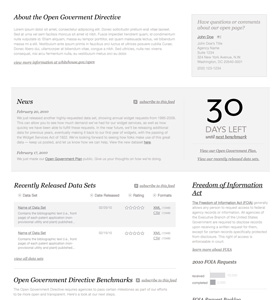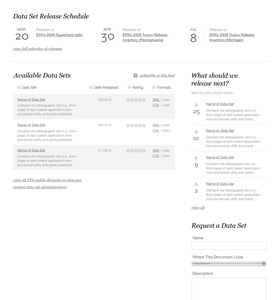Imagining /open
Last month President Obama unveiled his Open Government Directive to create further openness within the executive branch. This directive requires federal agencies to show how they are working toward transparency, public participation, and collaboration by requiring the addition of new web pages – “/open” pages – onto their existing sites. With the first deadline in the directive quickly approaching, we’ve put together our thoughts on what these pages should look like.
Since each government website has its own structure and style, we created wireframes – blueprints for web pages that lack visual design elements like color and texture. We hope that each agency will, like us, concentrate on the content of these pages and cohesively integrate them into their existing site’s structure and style. We imagine that many agencies will want to create small sites that have a different look and feel based on this new content, but we strongly encourage them to think about how they could keep this content as cohesive part of their site’s overall experience. Also, we should note that we have nodded to many of the requirements placed upon agencies under the OGD directive, our wireframes are merely a good start to comply with its directives; they are insufficient to comply with all its directives.
The Reveal
Since holding each agency accountable is a large part of the Open Government Directive, we’ve placed a lot of focus on those content areas. The White House, Congress and the American public should be able to quickly and easily see what each agency is required to accomplish, what they have accomplished, and how much time they have left until their next deadline.
We organized the landing page by dividing it into horizontal bands that target different users. The top band focuses on informing a newcomer about the purpose of the page, and clearly provides contact and vCard information for the official in charge of the effort so that users may give feedback for improvements. The second band focuses on the agency’s process towards meeting the OGD, showing recent news about the agency’s efforts alongside a clear display of deadlines and resources. Finally, the main content block displays agency progress in more detail, showing recently released data sets and the specifics surrounding the agency’s progress in meeting the directive requirements. The right-hand sidebar provides insight into FOIA requests and queue progress.
We wanted the data page to be a dashboard that allows the user to interact with the data by suggesting what should be released next, in addition to viewing the agency’s accomplishments and planned next steps. In our version, the main content area is a display of all data sets that have been released by this agency. For consistency, and so that information doesn’t easily become out-of-date, all data sets should ultimately reside on data.gov, so that each set may be edited and rated in one place. To accomplish this, we recommend that data.gov offer agencies a widget to consistently display the most up-to-date information available. On the right-hand sidebar, users should see that data sets have been requested by users, and be able to vote up the ones they’d like to see be released next.
Of course there are many good ways agencies could go about creating these pages. What all agencies should do, though, is consider their audience, and make their open pages approachable and accessible to both the general public as well as to the experts in Congress and the White House. They also should create a robust design, knowing that the upcoming weeks, months, and years will bring greater and broader releases of information. They should plan not just for the minimum requirements of the OGD, but it’s likely implementation over time, Through good design and attention to the audience, these pages can be an invaluable resource in opening up the government.
More information about the Open Government Directive, including suggestions to new media managers and a list of deadlines, is available at http://www.opencongress.org/wiki/Open_Government_Directive



